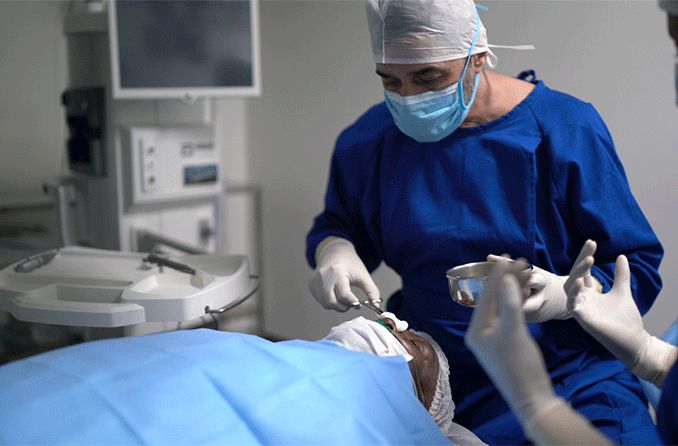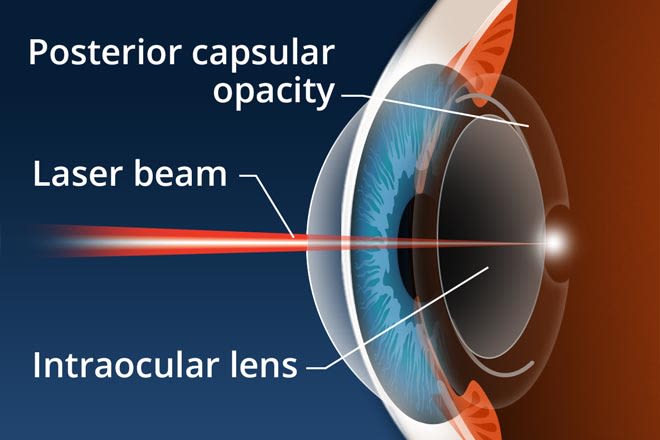Posterior capsular opacification (secondary cataract)

What is posterior capsular opacification?
Posterior capsular opacification (PCO) is clouding that forms on the thin, natural capsule or bag that holds your artificial lens in place. It's the most common side effect after cataract surgery.
The cloudy lens capsule can cause blurry vision and other eyesight problems. Eye doctors treat it with a simple laser procedure.
What is a secondary cataract?
Secondary cataract is just another name for posterior capsular opacification.
People use this nickname because secondary cataracts can cause some of the same problems as real cataracts. But a secondary cataract is not a real cataract.
A true cataract is clouding on your eye's natural lens, not the bag around it (called the lens capsule).
The natural lens is removed and replaced with an artificial lens during cataract surgery. This device is called an intraocular lens (IOL).
A secondary cataract only affects your lens capsule, not your IOL.
Can cataracts come back after surgery?
No, cataracts can't come back after they're removed.
Your IOL typically won't need to be replaced this time, so you won't need cataract surgery again.
READ MORE: What is a cataract?
Symptoms
Posterior capsular opacification symptoms can include:
Glare
Difficulty reading
A “secondary cataract” can cause problems with your contrast sensitivity too. This is your ability to see an object against a similar background.
Contrast problems are more noticeable in low light because you're trying to see dark objects against dark backgrounds.
Causes and development
After cataract surgery, certain cells are left behind inside your eye. These cells can move, grow and change over time.
If too many cells build up, they can make the back of your lens capsule look cloudy. This is posterior capsular opacification — a secondary cataract.
Light needs to pass through the lens capsule before you can see it. A cloudy capsule makes light scatter inside your eye. That leads to problems like blurry vision.
Posterior capsular opacification can take months or even years to develop behind your IOL.
Without treatment, your symptoms could get worse over time.
Schedule an eye exam any time you see changes in your vision. If the doctor diagnoses secondary cataracts, they'll talk to you about your treatment options and help you see clearly again.
Risk factors
Some people may have a higher chance of developing secondary cataracts after their cataract removal.
This includes people who:
Are younger
Have diabetes
Developed cataracts after injuries or other trauma
Have eye problems like uveitis or retinitis pigmentosa
Have myotonic dystrophy
Treatment
Doctors usually treat posterior capsular opacification with a surgery called YAG laser capsulotomy. It's safe and painless and only takes about five minutes.
How treatment works

A laser capsulotomy is a relatively simple, in-office procedure that takes only a few minutes. A laser beam is directed at the cloudy capsule behind the intraocular lens (IOL) and the energy from the laser vaporizes the tissue, restoring clear vision.
Secondary cataract surgery follows these steps:
Your doctor will numb your eyes with eye drops so you don't feel any pain. They might dilate your pupils, too.
They use a special laser to make an opening in the back of your lens capsule. This helps light travel through a clear opening instead of the cloudy capsule.
After surgery, you might need someone to drive you home. The doctor may ask you to use prescription eye drops for a few days.
Your vision should look clear within 24 hours.
The doctor won't need to make any incisions in your eye.
Your eyesight might look blurry for a few hours after your procedure. You may notice more eye floaters, too, but they should get better over time.
Risks
Serious complications are rare, but even minor surgeries have risks.
Risks include:
Your IOL moving out of place
IOL damage
Swelling inside your eye
Can you get posterior capsular opacification more than once?
Yes. You can get secondary cataracts again, even after a successful surgery. But it's rare.
The doctor will use the same YAG laser capsulotomy to treat each repeat problem.
Prevention
You can't prevent posterior capsular opacification. But researchers are working to find new solutions.
So far, most of their research has focused on different IOL materials, lens design, medications and surgery techniques.
Talk to an eye doctor
Posterior capsular opacification is very common. Around two in every five people who have cataract surgery get secondary cataracts.
Fortunately, the treatment is quick and safe. It can help you see clearly within 24 hours or less.
An optometrist or ophthalmologist can check your eyes for secondary cataracts during an eye exam. They will also make sure your symptoms aren't caused by a different problem altogether.
If you've recently noticed vision changes or want to talk to someone about your treatment options, schedule an appointment with an eye doctor near you.
Lens capsule. EyeSmart. American Academy of Ophthalmology. October 2019.
Posterior capsule opacification. EyeWiki. American Academy of Ophthalmology. August 2023.
Posterior capsular opacification. Cleveland Clinic. February 2023.
Comparison of two different contrast sensitivity devices in young adults with normal visual acuity with or without refractive surgery. Scientific Reports. July 2022.
Working with elders who have vision impairments. In Occupational Therapy with Elders: Strategies for the COTA (Fourth Edition). Mosby. 2019.
Prevention and management of diabetes-related eye disease. American Diabetes Association. 2019.
What is a posterior capsulotomy? EyeSmart. American Academy of Ophthalmology. September 2022.
Types of cataract. National Eye Institute. January 2023.
Posterior capsule opacification. Royal National Institute of Blind People. September 2022.
Page published on Thursday, September 9, 2021
Page updated on Tuesday, December 12, 2023
Medically reviewed on Tuesday, October 24, 2023






